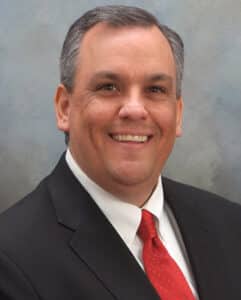
Seven-Generation Decision-Making
A major factor of sustainability is thinking about how we
Share:
Share:

stock.adobe.com / surassawadee
Experts weigh in on trends to watch, electrification, and how industry pros can make a difference in achieving greater sustainability and resiliency.
Since the 2017 release and 2020 update of IPMI’s Sustainability Framework, our industry has made great strides in utilizing our role and programs in parking, transportation, and mobility to further sustainability goals that support the triple bottom line of people, planet, and profit.
Per the framework, sustainability in parking and transportation means meeting “the needs of today without compromising the ability of future generations to meet their own needs. To be successful, transportation solutions and sustainable practices should balance economic feasibility, public health and welfare, and consideration of environmental effects. These sustainable practices work to reduce fossil fuel use and carbon emissions, air and water pollution, and land use.” IPMI continues to serve as a thought leader, information clearinghouse, and driving force for increasing sustainability practices throughout the industry.
This work was further developed to focus on industry-specific programs and policies in IPMI’s Mobility Framework. Parking & Mobility’s May 2022 issue takes a deeper dive into the intent, goals, and strategies in the framework. Developed by the IPMI Mobility Task Force, with expertise from our volunteers across our community, these guidelines offer an opportunity to review how their operations play a meaningful and impactful role to plan for greater mobility options as well as related sustainability initiatives.
Our ongoing strategic relationship with the United States Green Building Council (USGBC) and the Green Business Certification Institute (GBCI) represents our most significant collaboration in this work, culminating in our Parksmart Advisor program and ongoing support of the Parksmart program.
For this feature in our Earth Day issue, we consulted with experts from IPMI’s Sustainable Mobility Task Force to weigh in on how we can build on our progress and programs, as well as advance our work in the space as a community.
We asked several industry experts what their thoughts were on the current state of sustainability in parking, mobility, and transportation. Integrating electric vehicles into the mobility ecosystem is a huge challenge, but we also consider how to continue to reduce our industry’s impact on the environment in other ways. These experts have a lot of thoughts on how to shape sustainability.
Anoush Camille Razavian: When it comes to electrification, we must be strategic in the way we overhaul our predominantly gas-powered transportation system. Replacing every combustion engine vehicle with a partially or fully electric vehicle won’t reduce the carbon impact of energy wasted from vehicle congestion—the carbon will just enter the atmosphere from someplace else. This is where better curb management practices can help cities get the outcomes they need and want. The curb is the scarcest and increasingly most sought-after resource in the public right-of-way, and the effort to accelerate the transition to a more electrified transportation system will ultimately come down to pricing. Cities need to be able to start understanding what the breakdown is on their streets in terms of EV mode split by collecting and keeping a repository of data and sharing paradigms, to ultimately create financial incentives for e-cargo/electric fleet delivery. Once there is understanding on that front, deploying incentivized pricing will push the needle for a more overall electrified system.

Garrett Hofeld: Providing municipalities, universities, parking operators and EV users with eco-friendly charging solutions, wayfinding and enforcement. This includes reservation platforms, overstay enforcement (fully charged or paid charging expiry), preventing unauthorized use of charging stations, and wayfinding for available EV charging.
Stephen Kenny: How can cities ensure that EV charging—and the infrastructure that comes with it—works in harmony with all other modes of transportation? As more and more US cities adopt aggressive EV charger rollout strategies, we need to have a robust conversation about how that infrastructure will impact all modes. When EV chargers are installed at the curb, cities need to work across agencies to make sure those chargers pose minimal interference to 1) sidewalks, especially considering those in wheelchairs, 2) bicycle lanes, 3) street parking networks, and 4) curbside public transit systems like buses and light rail. Each of these modes are critical to a sustainable mobility system.

Ravali Kosaraju, PE, P.Eng. PTOE: EVs in operation are considered sustainable or “clean” due to zero emissions when compared to IC engine vehicles. However, the batteries used in EVs and electricity generation are still heavily reliant on non-renewable sources. Focus should be placed on finding innovative solutions to this challenge to truly make them sustainable. Another aspect to focus on is long distance travel and the reliability of EV charging to provide sufficient coverage.
Matthew Inman: As EV charging infrastructure continues to grow and mature, the management of charging stations needs to evolve as well. There are many locations across the country that still provide free and unlimited use of charging stations. This made sense in the past as communities wanted to encourage the adoption of EVs. However, as EV ownership has increased, free access can now result in the inefficient use of charging stations and make it difficult for EV drivers to find available charging. To encourage the efficient use of charging resources, parking managers should consider the implementation of reasonable charging and idle fees. Enforcement could also be a part of infrastructure management. For example, vehicles should be required to be actively charging while occupying a charging space and time limits could be enforced to help ensure more people can access charging stations. Improved management will help ensure spaces are available to those that truly need them—and reduce use by those that just want to top-off their batteries or take advantage of a prime parking space. Better management could also help generate funds for other important improvements, such as growing EV charging resources, improving systems and technologies (e.g., moving from Level 2 to Level 3 chargers), and moving toward renewable sources of energy for EV charging.

Victor Hill: We need to have a larger conversation about infrastructure and planning—one rooted in the realities of accounting for everything from the increased weights of electric vehicles and the associated needs for multi-level facilities to how to manage the increased power requirements to any facilities that will offer charging. Parking and mobility industry professionals must conduct a thorough review of infrastructure needs that require accommodations for EVs and other alternative fuel vehicles. It’s not just about EVs—it’s about the new reality that these vehicles and others present.
Brandy Stanley, CAPP, MBA: Figuring out how to communicate where available chargers are in an effective way; and making sure they are delivering the service level consumers will require. That requires someone to make sure the chargers are maintained and that reservations/time limits are enforced.
Jonathan Wicks, CAPP: Right size your number of EV charging stations installed just like right sizing total parking supply constructed.

Samuel Rea Patterson: For an academic institution with various reporting needs (leadership and administration), it has been critical to use a networked managed system that provides data such as availability, occupancy, number of sessions, length of sessions, and unique driver information with some cross-referencing to show the type of user being student, staff, or visitor. The data provides valuable guidance on current needs and future planning from a parking perspective.
Kurt Steiner, AICP, LEED AP: EV Ready provisions in building codes. As we see wider adoption of EVs, not all drivers will have easy access to at-home charging and equitable distribution of charging options will become a bigger consideration. Part of the solution is plentiful Level 2 charging in parking for multifamily residential buildings. Designing new buildings with the necessary infrastructure (electrical capacity, conduit, etc.) upfront during initial construction is the smart way to prepare and way less expensive compared to retrofitting existing parking.

Anoush Camille Razavian: There are several keys to making successful interventions to improve our transportation system in ways that will last and hold space for the exponentially increasing demand for not only existing types of mobility services, but also new ones to come. Historically, the cost of land or building space for folks to reside, work, or otherwise host their businesses has always come at steep cost in major urban areas, while the associated cost to store the travel vehicle has been free of charge. This model has seen significant shifts over recent years, however, primarily for passenger vehicle parking. Though demand for commercial food/goods delivery, rideshare, and other new mobility services has continued to increase, a cost for that loading/unloading activity still does not exist in many urban areas. This creates little opportunity to incentivize specific modes of transportation that can help decarbonize the network. Cities will need to not only price these areas at their value but track the demand data to reallocate existing curb space for the users of the curb that need the most critical right-of-way. This data will help inform which specific areas are in the direst need of intervention, and additionally, pairing the demand data with new rate proposals can help cities estimate what areas are forecasted to bring in the most new revenue. The ongoing theme is that we will not know what we are unable to know and establishing data reporting/collection methods to dynamically alter price will help achieve desired outcomes.

Trevyr Meade, LEED® Green Associate™: De-carbonization commitments, ESG investors and public funding such as the Inflation Reduction Act are creating a large pool of resources to help build a more sustainable economy. As decision makers determine how to allocate these resources it’s important that they understand how to effectively make parking and mobility more sustainable. This creates an opportunity for the parking and mobility community to engage investors, ESG framework providers, policy makers, climate think-tanks and sustainability executives in conversations about where dollars can be most well spent within our industry. Through conversations with these stakeholders, we will help bring more investment to our communities’ parking, transportation, and mobility programs. We will also ensure that our industry’s expertise shapes where sustainability-related parking and mobility investments are made, ensuring they have the intended impact.
Garrett Hofeld: I believe implementing wayfinding technology throughout the industry would make a significant positive impact to the environment. Yes, digital signage at the entrance of garages and surface lots is a step in the right direction. Wayfinding is not just for garages and surface lots but curbside spaces, loading zones, Uber/Lyft/ pick up/drop off, food delivery, etc.
More importantly, providing the public with a visually intuitive navigational wayfinding methodology throughout a city or university campus or an entire parking operator’s portfolio will have lasting impact. Pushing real time occupancy data to websites, social media sites, digital signage, city/campus parking apps so parkers can effectively maneuver to their desired location quickly and hassle free rather than the alternative of driving around searching for open parking spaces, garages, lots, delivery locations or EV charging stations. An effective navigational wayfinding solution reduces congestion, enhances the parkers’ experience, promotes economic growth and enhances community safety. Advertising, displaying speed limits or other traffic regulations, and providing paid & unpaid parking alternatives are just a few of the overall benefits of an eco-friendly directional wayfinding system.

Stephen Kenny: Cities and states around the country should take note of cities like Washington, D.C., Boston, Indianapolis, and Seattle that have rolled out robust plans to expand their bus priority networks. These networks allow bus service along critical corridors to be more frequent and reliable, raising ridership rates and reducing per-capita carbon emissions. NACTO and metropolitan planning organizations around the country have developed best practices and design guides for bus priority networks, and these plans will continue to evolve in coming years. The parking industry has been called on to develop new and innovative ways to ensure available parking for private vehicles while not interfering with bus priority networks, and this work will continue in coming years.
Ravali Kosaraju, PE, P.Eng. PTOE: EVs are helpful in reducing the carbon footprint and thus help in reducing the environmental impacts associated with transportation. That said, they are still vehicles that will result in congestion, collisions including fatal ones. There should be equal efforts, if not more on improving overall system efficiency. How can that be achieved? Provide equal priority to travel modes that reduce the number of vehicles (examples include, transit, carpool, rideshare, bicycles—electric and non-electric). Prioritize improvements for high capacity and/or lower speed vehicles. In the long term, reducing the total number of vehicles will be far more sustainable for the environment.

Matthew Inman: Parking facilities are more than just a place to park vehicles. They can also support a number of different transportation needs in a community. A parking lot or garage could function as a primary mobility hub—connecting people to a variety of transportation options, such as walking, biking, scooters, ridesharing, and mass transit. In addition to addressing local traffic and transportation needs, these mobility options can help extend the market area of a parking location; thereby maximizing the use of available parking resources, reducing the need to build more parking, and helping increase the financial performance of the parking location. Parking facilities can also support transportation needs in the community by providing space for last mile delivery services. Last mile delivery is often considered the most expensive and time-consuming part of shipping goods to consumers.
Parking facilities can help by acting as a hub for the final leg of the shipping process. Goods could be shipped to a parking facility in larger vehicles and then distributed to customers using smaller, more fuel-efficient vehicles. This would help improve local traffic, improve the effective use of more sustainable delivery vehicles (e.g., smaller electric vehicles or bicycles), and increase delivery speed—all of which can help make community members happier. There are certainly other ways parking facilities can help support the various transportation needs of a community. So, parking facility owners and managers should connect with community stakeholders to look for ways to leverage available parking resources as solutions to larger transportation issues.

Jonathan Wicks, CAPP: Parklets are more sustainable (and profitable) than on street parking. Consider encroachment fees for businesses occupying public right of way in lieu of hourly parking rates.
Brandy Stanley, CAPP, MBA: The loss of alternative transportation as a result of COVID is new and significant; single occupancy vehicles are more prevalent than they have been for years. One could argue this is offset by the work from home increase, but convincing people to take transit or other types of transportation is an even tougher battle than it was before.
Kurt Steiner, AICP, LEED AP: E-bike and micromobility are poised for continued growth and will help cities, towns, and campuses meet their VMT and emissions reduction targets by providing viable alternatives to driving for short and medium distance trips.
Anoush Camille Razavian: Though conversations about strategic curb management have been ongoing for the better part of the last decade, the onset of the pandemic has made these issues more relevant than ever before for regulators. Many cities are at the stage of evaluating which method will be the most effective at solving their curb related challenges, however, the impact will remain at zero until actual interventions are made. Cities will have the greatest opportunity to make an impact by implementing solutions, evaluating shifts in occupancy, revenue, and general activity, and using those metrics to continue the use of methods that deliver. The lever of power is in the hands of the regulators to get the outcomes they need and want, and it will require incentivizing desired behavior and penalizing violators. Understanding will be the key, and bidirectional data will be critical in the enablement of change in the network with respect to vehicle type (more EVs), vehicle size (carless delivery/e-cargo/smaller vehicles), and passenger vehicle mode shift. Cities need to outline their sustainability, efficiency, and safety goals, set their priorities, and start piloting—only with action can we yield results.
Stephen Kenny: Re-develop surface parking lots into multi-use residential and commercial developments. Our best hope for a future of sustainable mobility is one that prioritizes dense, multi-use, and walkable urban environments. While electric vehicles emit less carbon than gas-powered vehicles, they still have substantially higher lifetime per-capita carbon emissions than walking, biking, and public transit. Surface parking lots reduce density, therefore making those more sustainable modes more difficult to use. Therefore the biggest impact the parking industry can have on our communities is by re-developing surface parking lots in ways that promote sustainable mobility and less personal vehicle use.
Ravali Kosaraju, PE, P.Eng. PTOE: Providing equitable and safe mobility choices for users of all ages, abilities and socioeconomic background will truly bring the greatest impact. For far too long, we have focused on capacity improvements without prioritizing equity, access, and sustainability.
Matthew Inman: Some in our communities may not fully understand or appreciate the things we do—which could lead to challenges when implementing new strategies or technologies. One way to deal with this is to try using the basic principles of the ESG (Environmental, Social, and Governance) framework. ESG considers the impacts an organization has on its environment, communities, and employees to help ensure decisions are focused on limiting liabilities, increasing acceptance, and improving overall performance—all things that help keep a business or program a going concern. Some examples:
Victor Hill: We can lead the way with a clear, coherent plan to phase in the appropriate infrastructure that meets societal needs in a meaningful, practical way. Not every facility may require EV charging that could be better served in neighborhoods with disproportionate street parking or multi-family dwellings. Facility renovations and new facilities should similarly include consideration for green spaces and the ability to harness alternative energy sources such as solar and wind. Moreover, we need to find the right balance of alternative transportation (buses, carpools, cycling, etc.) and incentivize their use in a way that shows value/convenience. This latter point is something of an idealistic dream but one we need to push harder on with specific, meaningful ways to accomplish it.

Jonathan Wicks, CAPP: Prioritize walking and biking via Infill development, shared parking, and paid parking. Reducing the distance between destinations for those who choose to drive, sharing whatever parking supply is built, for an appropriate fee to cover cost of operations and maintenance.
Samuel Rea Patterson: For Universities, convincing folks to drive less! Build social marketing programs to incentivize and normalize biking, bussing, and car-Lite communities. Love the joy of hearing from folks that tried a new way to commute and love it. ◆
Brandy Stanley, CAPP, MBA, is Vice President at FLASH Parking and Co-Chair of the IPMI Sustainable Mobility Task Force.
Rachel Yoka, CAPP, LEED AP BD+C, is IPMI’s Chief Strategy Officer.

A major factor of sustainability is thinking about how we

EV Readiness Perspectives

Aside from electric and automated vehicle use, what “green” practices
Parking & Mobility is IPMI’s flagship publication, covering the news, trends, analysis, technologies, and people of the parking and mobility industry, and how it affects and influences communities around the world.
| Cookie | Duration | Description |
|---|---|---|
| cookielawinfo-checkbox-advertisement | 1 year | Set by the GDPR Cookie Consent plugin, this cookie is used to record the user consent for the cookies in the "Advertisement" category . |
| cookielawinfo-checkbox-analytics | 11 months | This cookie is set by GDPR Cookie Consent plugin. The cookie is used to store the user consent for the cookies in the category "Analytics". |
| cookielawinfo-checkbox-functional | 11 months | The cookie is set by GDPR cookie consent to record the user consent for the cookies in the category "Functional". |
| cookielawinfo-checkbox-necessary | 11 months | This cookie is set by GDPR Cookie Consent plugin. The cookies is used to store the user consent for the cookies in the category "Necessary". |
| cookielawinfo-checkbox-others | 11 months | This cookie is set by GDPR Cookie Consent plugin. The cookie is used to store the user consent for the cookies in the category "Other. |
| cookielawinfo-checkbox-performance | 11 months | This cookie is set by GDPR Cookie Consent plugin. The cookie is used to store the user consent for the cookies in the category "Performance". |
| CookieLawInfoConsent | 1 year | Records the default button state of the corresponding category & the status of CCPA. It works only in coordination with the primary cookie. |
| elementor | never | This cookie is used by the website's WordPress theme. It allows the website owner to implement or change the website's content in real-time. |
| viewed_cookie_policy | 11 months | The cookie is set by the GDPR Cookie Consent plugin and is used to store whether or not user has consented to the use of cookies. It does not store any personal data. |
| Cookie | Duration | Description |
|---|---|---|
| _ga | 2 years | The _ga cookie, installed by Google Analytics, calculates visitor, session and campaign data and also keeps track of site usage for the site's analytics report. The cookie stores information anonymously and assigns a randomly generated number to recognize unique visitors. |
| _ga_02PMHW8YWC | 2 years | This cookie is installed by Google Analytics. |
| _ga_LC0QJJHM3J | 2 years | This cookie is installed by Google Analytics. |
| _ga_V9KYTSBYT2 | 2 years | This cookie is installed by Google Analytics. |
| iutk | 5 months 27 days | This cookie is used by Issuu analytic system to gather information regarding visitor activity on Issuu products. |
| Cookie | Duration | Description |
|---|---|---|
| mc | 1 year 1 month | Quantserve sets the mc cookie to anonymously track user behaviour on the website. |
| Cookie | Duration | Description |
|---|---|---|
| ultp_view_1052 | 1 day | No description |
| ultp_view_1058 | 1 day | No description |
| ultp_view_1060 | 1 day | No description |
| ultp_view_1064 | 1 day | No description |
| ultp_view_1068 | 1 day | No description |
| ultp_view_1070 | 1 day | No description |
| ultp_view_1072 | 1 day | No description |
| ultp_view_1078 | 1 day | No description |
| ultp_view_1082 | 1 day | No description |
| ultp_view_1088 | 1 day | No description |
| ultp_view_1100 | 1 day | No description |
| ultp_view_1103 | 1 day | No description |
| ultp_view_1114 | 1 day | No description |
| ultp_view_1118 | 1 day | No description |
| ultp_view_1122 | 1 day | No description |
| ultp_view_1125 | 1 day | No description |
| ultp_view_1130 | 1 day | No description |
| ultp_view_1132 | 1 day | No description |
| ultp_view_1135 | 1 day | No description |
| ultp_view_1541 | 1 day | No description |
| ultp_view_1554 | 1 day | No description |
| ultp_view_1557 | 1 day | No description |
| ultp_view_1560 | 1 day | No description |
| ultp_view_1563 | 1 day | No description |
| ultp_view_1568 | 1 day | No description |
| ultp_view_1572 | 1 day | No description |
| ultp_view_1576 | 1 day | No description |
| ultp_view_1580 | 1 day | No description |
| ultp_view_2305 | 1 day | No description |
| ultp_view_2321 | 1 day | No description |
| ultp_view_2338 | 1 day | No description |
| ultp_view_2342 | 1 day | No description |
| ultp_view_259 | 1 day | No description |
| ultp_view_270 | 1 day | No description |
| ultp_view_275 | 1 day | No description |
| ultp_view_286 | 1 day | No description |
| ultp_view_3074 | 1 day | No description |
| ultp_view_3115 | 1 day | No description |
| ultp_view_3334 | 1 day | No description |
| ultp_view_3336 | 1 day | No description |
| ultp_view_3338 | 1 day | No description |
| ultp_view_3340 | 1 day | No description |
| ultp_view_3346 | 1 day | No description |
| ultp_view_3354 | 1 day | No description |
| ultp_view_3361 | 1 day | No description |
| ultp_view_3367 | 1 day | No description |
| ultp_view_365 | 1 day | No description |
| ultp_view_367 | 1 day | No description |
| ultp_view_38 | 1 day | No description |
| ultp_view_3846 | 1 day | No description |